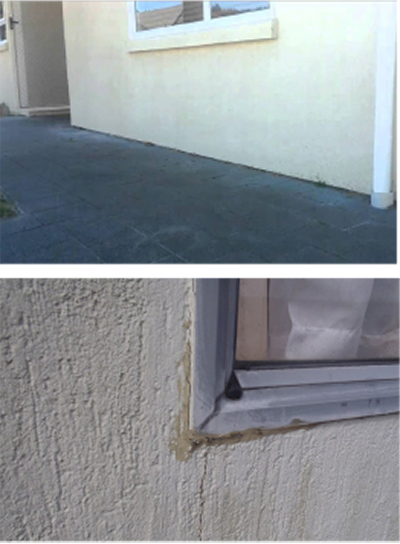The ‘leaky homes crisis’ is an ongoing construction and legal predicament in New Zealand. A perfect storm of trending building design features and the use of untreated timber culminated in many homes built between 1994 -2004 that suffered from weather-tightness problems. Hawke’s Bay has its share of homes built in this era but to date there has been relatively little impact on the value of these homes when they have come to sell.
There are many reasons why homes from this era were leaky. A major one was the increase in the use of cladding systems such as fibre cement sheet and EIPS1, more commonly known as monolithic cladding, that relied on a paint finish as the primary defence against water ingress. Such cladding systems allowed for little construction or thermal movement so that fine cracks that appeared insignificant, and would have been relatively insignificant in traditional claddings such as weatherboard, allowed continuous ingress of moisture into the framing which were ideal for rot. A further exacerbating factor was the change to the New Zealand Standard for Timber Treatment in 1995, allowing the use of untreated Pinus radiata timber for wall framing. As this timber has little natural resistance to rot when wet, damage occurs more quickly.
Hence, nearly a decade on it appears there continues to be a stigma associated with homes built in this era, especially if they display cladding and design features associated with weather tightness issues. Therefore, any home with a monolithic cladding became a red flag for buyers, especially in the bigger city property markets. We are beginning to see this stigma shift to Hawkes Bay homes built in this era as we see more buyers from out of town enter the local property market, irrespective of any weather tightness issues or their actual condition. Not only has our office had this experience, we have also had feedback from Real Estate Agents who confirm that over the past 18 months it has become increasingly difficult to sell property with this cladding type. Furthermore, it is having a definite impact on the consideration vendors are receiving. However, how much of an impact remains to be quantified?
In late 2016 researchers2 from Massey University released a paper entitled Leaky Building Stigma: Can it be Eliminated by Remediation. The purpose of the study was to examine whether meeting the regulatory standards for remediation work eliminated the negative stigma effect on remediated properties or whether the stigma remained. The study’s findings indicated that for monolithic- clad dwellings, the price discount due to leaky building stigma is significant. Depending on the severity of the leaking problems, there is about 11% reduction of value, on average, for general market stigma and an additional 5% -10% for post-remediation stigma.
Earlier this year, our office valued a home with a monolithic cladding system. There were no signs of the home leaking, however (in a strong market) the home sold for 11.26% below our valuation. As a Trustee I am also involved in a sale of a property with a monolithic cladding system. The house has not sold yet and is not leaking but certainly carries the stigma of such. We have had two contracts fall over due to outside advisors strongly recommending their clients seek a home with a different cladding type. Based on both offers to date it would suggest a 9.5% reduction on valuation however this may yet be greater as the home has not sold yet. Therefore, the above research may prove to be relatively accurate in its estimates of value discounts.
Whilst Hawke’s Bay has had its share of properties affected by the ‘leaky home’ syndrome, it has not been on the same scale as that of other cities, especially Auckland. It remains to be seen if our out of town buyers will continue to influence the perceived stigma of homes built in this era on our local property values.
- Externally Insulated Plaster System
- Song Shi, Iona McCarthy, Uyen Mai



